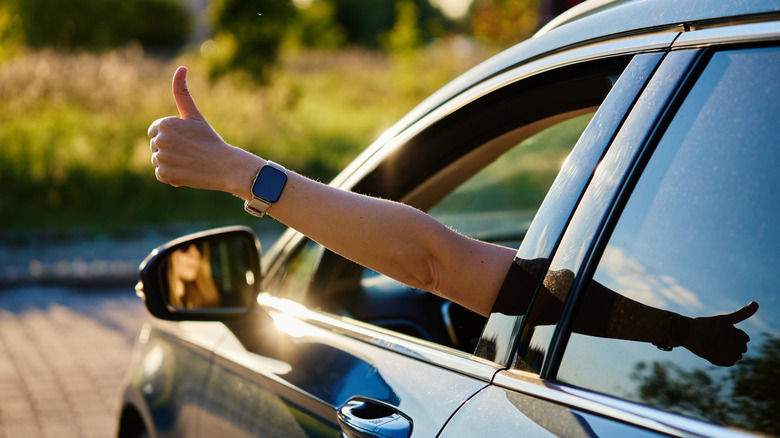What Tourists In The US Notice About How Americans Talk And Gesture To Each Other
American travelers are often encouraged to learn popular European gestures before a trip, but what about international tourists observing American behavior? As with any sort of travel, international visitors have to adjust to more than just new cities and foods when visiting the U.S. It also means navigating a sea of unfamiliar body language and facial expressions. PennState Harrisburg rounded up reactions to this topic from international students in "An International Student's Guide to American Culture and Etiquette."
One of the first things many visitors notice is just how animated Americans are when they speak. You may have thought Italian hand gestures are the epitome of passionate body language, but it turns out that Americans also talk with their hands, according to tourists. Hands move dramatically and facial expressions seem exaggerated, especially compared to more reserved cultures. "In Japan, people do not use so many kinds of gestures, so I was surprised that American people move their hands so aggressively when they talk," Akiho Suzuki of Japan noted. "The only movements Japanese people make in conversations are nodding and shaking the head. So at first I couldn't focus on the conversations because I was worried that their hands would accidentally hit me."
Facial expressions can be equally perplexing. As Suzuki noted, it's common for someone in the U.S. to furrow their brow when confused or unsure — but for someone still learning English, this could come off as frustrated, angry, or impatient. "I was scared every time ... because I thought the person was angry at my bad English pronunciation," Suzuki said. Adi Divakar Venu from India also shared something they learned in the U.S.: "Some people here may seem rude because of the things they say, but they don't say such things thinking that they are rude."
Unexpected challenges with gestures in American conversation
For international tourists getting to know any new culture, it's not unusual for common signals to get misread entirely. One of the biggest surprises for some visitors is how Americans use their hands to say things like "come here" or "go away." In the U.S., calling someone over often involves a palm-up motion with one or more fingers curling inward. But in Japan, this motion is similar to how you'd call a dog. Suzuki shared, "The American beckoning sign with moving one or two fingers looks impolite to me."
While that seems like a mild mixup, some gestures made with good intentions could be interpreted as rude in other cultures. Take the "thumbs up" as an example. You might offer encouragement in the U.S. with a thumbs up, but this gesture can be wildly offensive elsewhere. Same goes for the "okay" sign made by circling the thumb and index finger. Do that in Brazil or certain Middle Eastern countries and you certainly won't be making any friends.
Context matters, so it's worth taking care before gesturing in another country without knowing how it will go over. Research local customs and etiquette, learn essential phrases like "please" and "thank you" in the local language, and observe how locals interact with one another. It's not a bad idea to err on the side of caution, either — if you aren't sure about a gesture, just skip it. That said, no one is perfect, so a little understanding and empathy for our cultural differences can make a big difference. At the end of the day, the best ways to avoid being what Rick Steves calls the "ugly tourist" is to stay open-minded, respectful, and humble throughout your travels.

